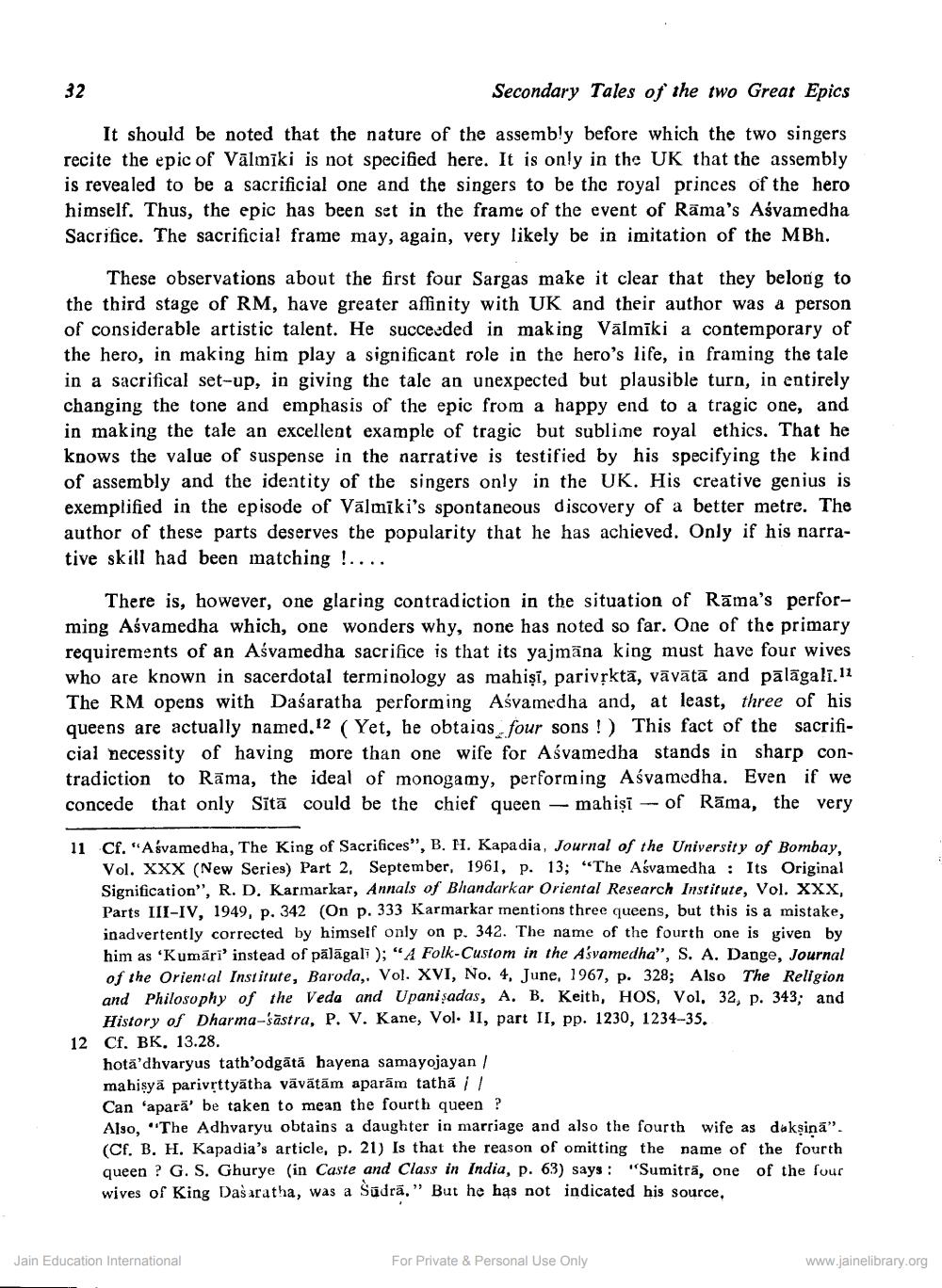________________
32
Secondary Tales of the two Great Epics
It should be noted that the nature of the assembly before which the two singers recite the epic of Vālmīki is not specified here. It is only in the UK that the assembly is revealed to be a sacrificial one and the singers to be the royal princes of the hero himself. Thus, the epic has been set in the frame of the event of Rāma's Aśvamedha Sacrifice. The sacrificial frame may, again, very likely be in imitation of the MBh.
These observations about the first four Sargas make it clear that they belong to the third stage of RM, have greater affinity with UK and their author was a person of considerable artistic talent. He succeeded in making Vālmīki a contemporary of the hero, in making him play a significant role in the hero's life, in framing the tale in a sacrifical set-up, in giving the tale an unexpected but plausible turn, in entirely changing the tone and emphasis of the epic from a happy end to a tragic one, and in making the tale an excellent example of tragic but sublime royal ethics. That he knows the value of suspense in the narrative is testified by his specifying the kind of assembly and the identity of the singers only in the UK. His creative genius is exemplified in the episode of Vālmīki's spontaneous discovery of a better metre. The author of these parts deserves the popularity that he has achieved. Only if his narrative skill had been matching !....
There is, however, one glaring contradiction in the situation of Rāma's performing Aśvamedha which, one wonders why, none has noted so far. One of the primary requirements of an Aśvamedha sacrifice is that its yajmäna king must have four wives who are known in sacerdotal terminology as mahişī, parivěktā, vāvātā and pālāgalī.12 The RM opens with Dasaratha performing Aśvamedha and, at least, three of his queens are actually named,12 ( Yet, he obtains, four sons !) This fact of the sacrificial necessity of having more than one wife for Aśvamedha stands in sharp contradiction to Rāma, the ideal of monogamy, performing Aśvamedha. Even if we concede that only Sītā could be the chief queen -- mahişi -- of Rāma, the very
11 Cf. "Asvamedha, The King of Sacrifices", B. H. Kapadia, Journal of the University of Bombay,
Vol. XXX (New Series) Part 2. September, 1961, p. 13; "The Asvamedha : Its Original Signification", R. D. Karmarkar, Annals of Bhandarkar Oriental Research Institute, Vol. XXX, Parts III-IV, 1949, p. 342 (On p. 333 Karmarkar mentions three queens, but this is a mistake, inadvertently corrected by himself only on p. 342. The name of the fourth one is given by him as 'Kumāri' instead of pālāgali); "A Folk-Custom in the Asvamedha", S. A. Dange, Journal of the Oriental Institute, Baroda,, Vol. XVI, No. 4, June, 1967, p. 328; Also The Religion and Philosophy of the Veda and Upani şadas, A. B. Keith, HOS, Vol. 32, p. 343; and
History of Dharma-śāstra, P. V. Kane, Vol. II, part II, pp. 1230, 1234-35. 12 Cf. BK, 13.28.
hota'dhvaryus tath'odgāta hayena samayojayan / mahişyä parivíttyätha vāvātām aparām tathā il Can 'aparä' be taken to mean the fourth queen ? Also, "The Adhvaryu obtains a daughter in marriage and also the fourth wife as dakşinā". (Cf. B. H. Kapadia's article, p. 21) Is that the reason of omitting the name of the fourth queen ? G. S. Ghurye (in Caste and Class in India, p. 63) says: "Sumitrā, one of the four wives of King Dasaratha, was a Sūdrā.” But he has not indicated his source.
Jain Education International
For Private & Personal Use Only
www.jainelibrary.org




